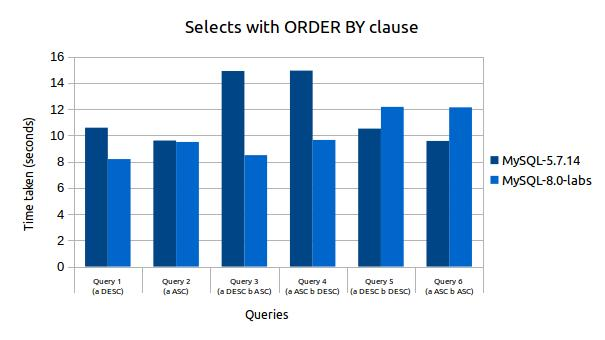共计 7292 个字符,预计需要花费 19 分钟才能阅读完成。
MySQL 8.0 终于支持降序索引了。其实,从语法上,MySQL 4 就支持了,但正如官方文档所言,”they are parsed but ignored”,实际创建的还是升序索引。
无图无真相,同一个建表语句,看看 MySQL 5.7 和 8.0 的区别。
create table slowtech.t1(c1 int,c2 int,index idx_c1_c2(c1,c2 desc));
MySQL 5.7
mysql> show create table slowtech.t1\G
*************************** 1. row ***************************
Table: t1
Create Table: CREATE TABLE `t1` (
`c1` int(11) DEFAULT NULL,
`c2` int(11) DEFAULT NULL,
KEY `idx_c1_c2` (`c1`,`c2`)
) ENGINE=InnoDB DEFAULT CHARSET=latin1
1 row in set (0.00 sec)
虽然 c2 列指定了 desc,但在实际的建表语句中还是将其忽略了。再来看看 MySQL 8.0 的结果。
mysql> show create table slowtech.t1\G
*************************** 1. row ***************************
Table: t1
Create Table: CREATE TABLE `t1` (
`c1` int(11) DEFAULT NULL,
`c2` int(11) DEFAULT NULL,
KEY `idx_c1_c2` (`c1`,`c2` DESC)
) ENGINE=InnoDB DEFAULT CHARSET=utf8mb4 COLLATE=utf8mb4_0900_ai_ci
1 row in set (0.00 sec)
c2 列还是保留了 desc 子句。
降序索引的意义
如果一个查询,需要对多个列进行排序,且顺序要求不一致。在这种场景下,要想避免数据库额外的排序 -“filesort”,只能使用降序索引。还是上面这张表,来看看有降序索引和没有的区别。
MySQL 5.7
mysql> explain select * from slowtech.t1 order by c1,c2 desc;
+—-+————-+——-+————+——-+—————+———–+———+——+——+———-+—————————–+
| id | select_type | table | partitions | type | possible_keys | key | key_len | ref | rows | filtered | Extra |
+—-+————-+——-+————+——-+—————+———–+———+——+——+———-+—————————–+
| 1 | SIMPLE | t1 | NULL | index | NULL | idx_c1_c2 | 10 | NULL | 1 | 100.00 | Using index; Using filesort |
+—-+————-+——-+————+——-+—————+———–+———+——+——+———-+—————————–+
1 row in set, 1 warning (0.00 sec)
MySQL 8.0
mysql> explain select * from slowtech.t1 order by c1,c2 desc;
+—-+————-+——-+————+——-+—————+———–+———+——+——+———-+————-+
| id | select_type | table | partitions | type | possible_keys | key | key_len | ref | rows | filtered | Extra |
+—-+————-+——-+————+——-+—————+———–+———+——+——+———-+————-+
| 1 | SIMPLE | t1 | NULL | index | NULL | idx_c1_c2 | 10 | NULL | 1 | 100.00 | Using index |
+—-+————-+——-+————+——-+—————+———–+———+——+——+———-+————-+
1 row in set, 1 warning (0.00 sec)
两者的对比可以看出,MySQL 8.0 因为降序索引的存在,避免了“filesort”。
这其实是降序索引的主要应用场景。如果只对单个列进行排序,降序索引的意义不是太大,无论是升序还是降序,升序索引完全可以应付。还是同样的表,看看下面的查询。
MySQL 5.7
mysql> explain select * from slowtech.t1 order by c1;
+—-+————-+——-+————+——-+—————+———–+———+——+——+———-+————-+
| id | select_type | table | partitions | type | possible_keys | key | key_len | ref | rows | filtered | Extra |
+—-+————-+——-+————+——-+—————+———–+———+——+——+———-+————-+
| 1 | SIMPLE | t1 | NULL | index | NULL | idx_c1_c2 | 10 | NULL | 1 | 100.00 | Using index |
+—-+————-+——-+————+——-+—————+———–+———+——+——+———-+————-+
1 row in set, 1 warning (0.00 sec)
mysql> explain select * from slowtech.t1 order by c1 desc;
+—-+————-+——-+————+——-+—————+———–+———+——+——+———-+————-+
| id | select_type | table | partitions | type | possible_keys | key | key_len | ref | rows | filtered | Extra |
+—-+————-+——-+————+——-+—————+———–+———+——+——+———-+————-+
| 1 | SIMPLE | t1 | NULL | index | NULL | idx_c1_c2 | 10 | NULL | 1 | 100.00 | Using index |
+—-+————-+——-+————+——-+—————+———–+———+——+——+———-+————-+
1 row in set, 1 warning (0.00 sec)
虽然 c1 是升序索引,但在第二个查询中,对其进行降序排列时,并没有进行额外的排序,使用的还是索引。在这里,大家容易产生误区,以为升序索引就不能用于降序排列,实际上,对于索引,MySQL 不仅支持正向扫描,还可以反向扫描。反向扫描的性能同样不差。以下是官方对于降序索引的压测结果,测试表也只有两列(a,b),建了一个联合索引(a desc,b asc),感兴趣的童鞋可以看看,http://mysqlserverteam.com/mysql-8-0-labs-descending-indexes-in-mysql/

而在 8.0 中,对于反向扫描,有一个专门的词进行描述“Backward index scan”。
MySQL 8.0
mysql> explain select * from slowtech.t1 order by c1;
+—-+————-+——-+————+——-+—————+———–+———+——+——+———-+————-+
| id | select_type | table | partitions | type | possible_keys | key | key_len | ref | rows | filtered | Extra |
+—-+————-+——-+————+——-+—————+———–+———+——+——+———-+————-+
| 1 | SIMPLE | t1 | NULL | index | NULL | idx_c1_c2 | 10 | NULL | 1 | 100.00 | Using index |
+—-+————-+——-+————+——-+—————+———–+———+——+——+———-+————-+
1 row in set, 1 warning (0.00 sec)
mysql> explain select * from slowtech.t1 order by c1 desc;
+—-+————-+——-+————+——-+—————+———–+———+——+——+———-+———————————-+
| id | select_type | table | partitions | type | possible_keys | key | key_len | ref | rows | filtered | Extra |
+—-+————-+——-+————+——-+—————+———–+———+——+——+———-+———————————-+
| 1 | SIMPLE | t1 | NULL | index | NULL | idx_c1_c2 | 10 | NULL | 1 | 100.00 | Backward index scan; Using index |
+—-+————-+——-+————+——-+—————+———–+———+——+——+———-+———————————-+
1 row in set, 1 warning (0.00 sec)
终于不再对 group by 进行隐式排序
由于降序索引的引入,MySQL 8.0 再也不会对 group by 操作进行隐式排序。
下面看看 MySQL 5.7 和 8 中的测试情况
create table slowtech.t1(id int);
insert into slowtech.t1 values(2);
insert into slowtech.t1 values(3);
insert into slowtech.t1 values(1);
MySQL 5.7
mysql> select * from slowtech.t1 group by id;
+——+
| id |
+——+
| 1 |
| 2 |
| 3 |
+——+
3 rows in set (0.00 sec)
mysql> explain select * from slowtech.t1 group by id;
+—-+————-+——-+————+——+—————+——+———+——+——+———-+———————————+
| id | select_type | table | partitions | type | possible_keys | key | key_len | ref | rows | filtered | Extra |
+—-+————-+——-+————+——+—————+——+———+——+——+———-+———————————+
| 1 | SIMPLE | t1 | NULL | ALL | NULL | NULL | NULL | NULL | 3 | 100.00 | Using temporary; Using filesort |
+—-+————-+——-+————+——+—————+——+———+——+——+———-+———————————+
1 row in set, 1 warning (0.00 sec)
“Using filesort”,代表查询中有排序操作,从结果上看,id 列确实也是升序输出。
MySQL 8.0
mysql> select * from slowtech.t1 group by id;
+——+
| id |
+——+
| 2 |
| 3 |
| 1 |
+——+
3 rows in set (0.00 sec)
mysql> explain select * from slowtech.t1 group by id;
+—-+————-+——-+————+——+—————+——+———+——+——+———-+—————–+
| id | select_type | table | partitions | type | possible_keys | key | key_len | ref | rows | filtered | Extra |
+—-+————-+——-+————+——+—————+——+———+——+——+———-+—————–+
| 1 | SIMPLE | t1 | NULL | ALL | NULL | NULL | NULL | NULL | 3 | 100.00 | Using temporary |
+—-+————-+——-+————+——+—————+——+———+——+——+———-+—————–+
1 row in set, 1 warning (0.01 sec)
不仅结果没有升序输出,执行计划中也没有“Using filesort”。
可见,MySQL 8.0 对于 group by 操作确实不再进行隐式排序。
从 5.7 升级到 8.0,依赖 group by 隐式排序的业务可要小心咯。
参考文档
http://mysqlserverteam.com/mysql-8-0-labs-descending-indexes-in-mysql/















